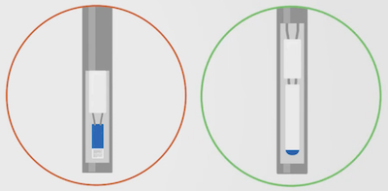
Temperature sensors are essential measuring instruments for ensuring the safety and efficiency of countless industrial processes. While RTDs and thermocouples both provide accuracy and reliability, each has pros and cons that make them better suited for particular applications.
Resistance thermometers (RTDs) and thermocouples are the two most common types of electronic temperature sensors used in industrial processes. The choice of which one to use depends on a variety of factors. First let’s take a look at what RTDs and thermocouples are, and how they differ from one another.

RTD
What is an RTD, and how does it work?
RTD stands for resistance temperature detector. This instrument is also called a resistance thermometer and, redundantly, an RTD probe or RTD sensor.
Within an RTD is a sensing element (resistor) that uses the change in electrical resistance of metal to determine the temperature. The most common metal in RTDs is platinum (Pt), as it is very chemically inert and has an almost linear temperature vs. resistance relationship. Platinum RTDs are often referred to as Pt100 sensors or Pt1000 sensors; the number refers to platinum’s nominal resistance (ohm Ω) at 0°C. Other metals used in RTDs are copper, nickel, and tungsten, but WIKA’s RTDs are made of platinum primarily because this metal has excellent stability, resists contamination, and its electrical resistance does not degrade over time.
Regardless of the metal used, its electrical resistance at specific temperatures is a known constant. As the temperature changes, so does the metal wire’s resistance. So, by comparing the known resistance to the measured resistance, one can calculate the temperature.
Types of RTDs

Thin-film (left) and wire-wound resistors
There are two main types of resistance thermometers used today: thin-film and wire-wound.
- Thin-film resistors are made up of a very fine layer of platinum deposited on ceramic and sealed by glass.
- Wire-wound resistors consist of a wire wrapped around and embedded inside a glass or ceramic casing.
The choice of thin-film vs. wire-wound depends mainly on the desired accuracy, temperature ranges to be measured, and whether the application experiences significant vibration.
RTDs also come with different numbers of wires in the cable.
- 2-wire RTDs are the most basic type, with the two lead wires creating a circuit. This circuit adds the resistance of the lead wires to the resistance of the RTD, which reduces its accuracy.
- 3-wire RTDs have an extra wire to compensate for the lead wire resistance, resulting in more accurate temperature measurements.
- 4-wire RTDs are even more accurate, as the configuration allows for constant compensation. This type of RTD is the temperature sensor of choice for laboratory applications.
The Pros and Cons of RTDs
Resistance thermometers are popular for many reasons:
- High accuracy, up to class AA (4-wire RTD)
- High repeatability
- Excellent linearity (Pt100 and Pt1000)
- Wide compatibility with instruments and processes due to their widespread use
- Excellent long-term stability
- Easy installation, as no extension wires are required
- Ease of calibration
- Suitable for temperatures between −321°F (−196°C) to 1,112°F (600°C).
On the other hand, RTDs cannot withstand extremely high temperatures, such as those found in chemical, petrochemical, and refinery applications. Pt100 and Pt1000 sensors can be expensive, due to the high cost of platinum. There’s also the possibility of self-heating errors, and compared to thermocouples, RTDs have a slower response time and are more susceptible to extreme shock and vibration.

Thermocouple with connection cable
What is a thermocouple, and how does it work?
Thermocouples are temperature sensors with a pair of dissimilar wires, each with a different electrical property at different temperatures. The working principle of thermocouples is that thermal energy is converted to electrical energy. At one end of the thermocouple, the two wires are welded or otherwise connected; this is the measuring point. When the temperature changes at this point, so does the electron density of each metal. The difference in temperature between the two metals creates a thermoelectric voltage. Since the relationship between temperature and voltage is known, this measured voltage is used to determine the temperature reading.
Types of Thermocouples
Thermocouples come in many different types, based on the pairing of dissimilar metals. Some of the common metal pairings are:
- Iron and copper–nickel (type J)
- Copper and copper–nickel (type T)
- Nickel–chromium and nickel-aluminum (type K)

Thermocouples are made of two metals with different electron densities.
Most thermocouples are made of relatively inexpensive base metals, although some have metal pairings containing more expensive platinum, rhodium, rhenium, and tungsten.
The Pros and Cons of Thermocouples
The main advantage of thermocouples is their ability to withstand extremely high temperatures. Tungsten-based thermocouples can be used even in applications reaching 4,200°F (2,320°C). This makes them the ideal temperature sensor for ammonia applications, sulfur recovery units, refinery furnaces, syngas reactors, glass production, aerospace, semiconductors, and more. Thermocouples also perform more reliably in in high-pressure and high-vibration environments.
In addition to their ruggedness in extreme conditions, thermocouples are also less expensive than RTDs and have a faster response time with their smaller diameter.
On the other hand, thermocouples are less stable than RTDs, their temperature vs. voltage relationship is less linear, and an extension wire is required, making installation more involved. Over time, a thermocouple experiences aging and drifting, and extremely high temperatures can lead to grain growth.
How to Choose between RTD and Thermocouple
In some applications, it doesn’t matter very much whether you use a resistance thermometer or a thermocouple. Other times, one type is definitely better than the other. In general, thermocouples are better for high-temperature and high-vibration processes, applications that require fast response times, and those with limited space. RTDs offer better accuracy, repeatability, and stability.
RTD | Thermocouple | |
Operating temperature range | −321°F (−196°C) to | −328°F (−200°C) to |
Higher accuracy | ✓ | |
Higher repeatability | ✓ | |
Better performance in high-vibration environments | ✓ | |
Better reliability in high-pressure environments | ✓ | |
Higher cost | ✓ | |
Faster response time | ✓ | |
Higher stability | ✓ | |
Better linearity | ✓ | |
Easier installation | ✓ |
Ultimately, when choosing a temperature sensor, you need to consider the application’s
- Temperature range
- Pressure range
- Humidity
- Shock and vibration
- Media (solid, liquid, or gaseous; corrosive; hazardous)
- Flow rate
In addition, some applications require the use of a thermowell to protect the temperature sensor from the process media, which affects the response time.
Choosing the right temperature sensor can be complex. For best results, contact the temperature specialists at WIKA USA for personalized advice on which instrument is the best fit your application and budget.

